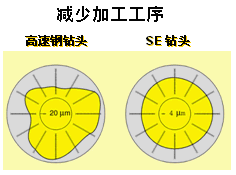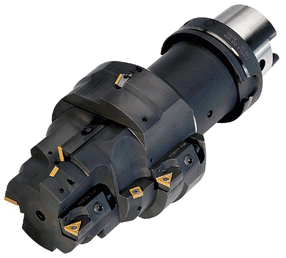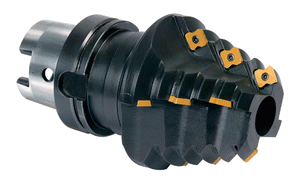In terms of improving processing efficiency, reducing the number of processing steps and performing composite processing is also a very effective means to improve processing efficiency.
Reduce processing steps
When I talked with my colleagues in many manufacturing companies, I found that they usually pay more attention to the three major elements of cutting (cutting speed, feed, depth of cut), but did not pay enough attention to reduce the processing. In fact, reducing the number of processing steps is often more effective than increasing the cutting parameters.
For example, locating pin holes are one of the most common elements in machining and are encountered in many parts. I have seen most of the factories use the process of drilling → reaming → reaming to complete the processing of this element. Because some of the pinholes themselves are not large in diameter, some users find that the use of cemented carbide is not very practical for improving the cutting speed. High-speed steel drill bits are still used for drilling, and then reaming and reaming are performed. However, due to the poor rigidity of the high-speed steel drill bit (the Young's modulus of high-speed steel is only 1/3 of that of cemented carbide), it is particularly prone to the hole roundness when drilling, we have to add a The hole process prevents the reaming from reaching the product quality requirements due to error re-listing. The rigidity of the cemented carbide is better, and now some structures that optimize the processing quality can often eliminate the process of reaming.

The picture on the right is a comparison of the roundness of their solid carbide SE drills with ordinary high speed steel drill bits provided by Kenner. In this comparison, the roundness of the high-speed steel drill bit reaches 20 祄, and the roundness of the SE drill bit as a solid carbide drill is only 1/5 of the former. According to this comparison result, we can completely consider the process of eliminating the reaming, and in some cases, it can even replace the less demanding reaming (such as when making the threaded bottom hole for extruding the tap).
Current direct milling of hard materials is also an effective way to reduce the number of machining operations. During my service at Walter, I conducted a direct milling test of hard materials at Shanghai Shenmo Mould Manufacturing Co., Ltd. of Shanghai Jiaotong University. I remember that it was a 16 mm diameter blade-finished ball-end milling cutter F2139, a titanium-nitrogen-aluminum-titanium coated ultra-fine grained carbide with a cutting depth of 0.7 mm, a row spacing of 0.5 mm and a rotational speed of 7000 r/min. The machined workpiece is a steel that has been heat treated to 50 HRC. The processing was carried out continuously for about 1 hour and 20 minutes, and the intended target was successfully completed. The flank of the blade was worn by about 0.15 mm, and it should be considered that cutting can be continued completely.
Such hard material milling is equivalent to combining the conventional roughing before the heat treatment and the semi-finishing after the heat treatment, which greatly saves a lot of time including positioning and clamping, and is also very helpful for improving the processing efficiency. .
 Composite hole machining tool |
 Forming cutter for roughing of blade roots |
Compound processing
Composite processing is another very effective means of increasing processing efficiency. Several processes are combined and completed in one process, at least reducing tool changes and saving time. Sometimes even a few processes are carried out at the same time, which saves more processing time. Step drill is the simplest and most common type of composite machining tool. Most of the small hole machining needs to be chamfered at the hole. The step drill is chamfered at the final stage of drilling completion, and the chamfering is completed while the drilling is completed.
The picture on the right is a composite hole machining tool from Walter. It can complete the three-semi-finishing of the three-diameter holes and the corresponding chamfering in one feed: the part of the blade can be seen from the front to complete the semi-precision and the middle diameter of the small diameter and large diameter two diameter segments. The upper part can only see the part of the flank of the blade to complete the middle diameter of the semi-precision and the small diameter, large diameter chamfer.
The lower right figure is Walter's forming cutter for roughing the roots of steam turbine blades. If you do not use a forming tool, you can use the universal ball-end milling cutter to run the program. The processing time will be very long and the efficiency will be low. The forming cutter can finish the roughing of the profile at one time, and the machining efficiency is naturally much higher.
Axial Flow Submersiblepump,Vertical Axial Mixed Flow Submersible Pump,High Flow Submersiblepump,Dirty Water High Flow Submersible Pump
Zhengzhou Shenlong Pump Industry CO.,Ltd , http://www.waterpump-manufacturer.com